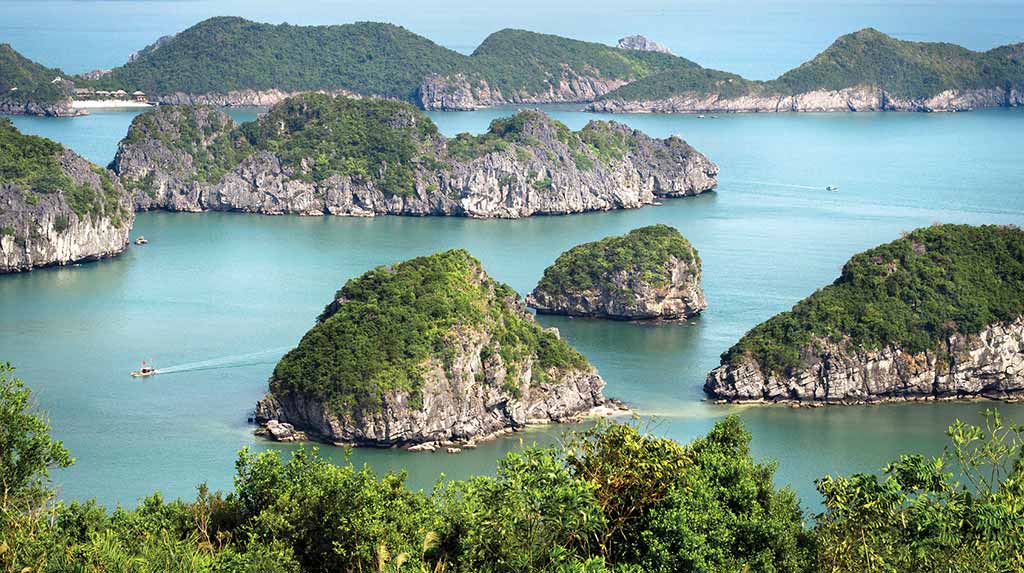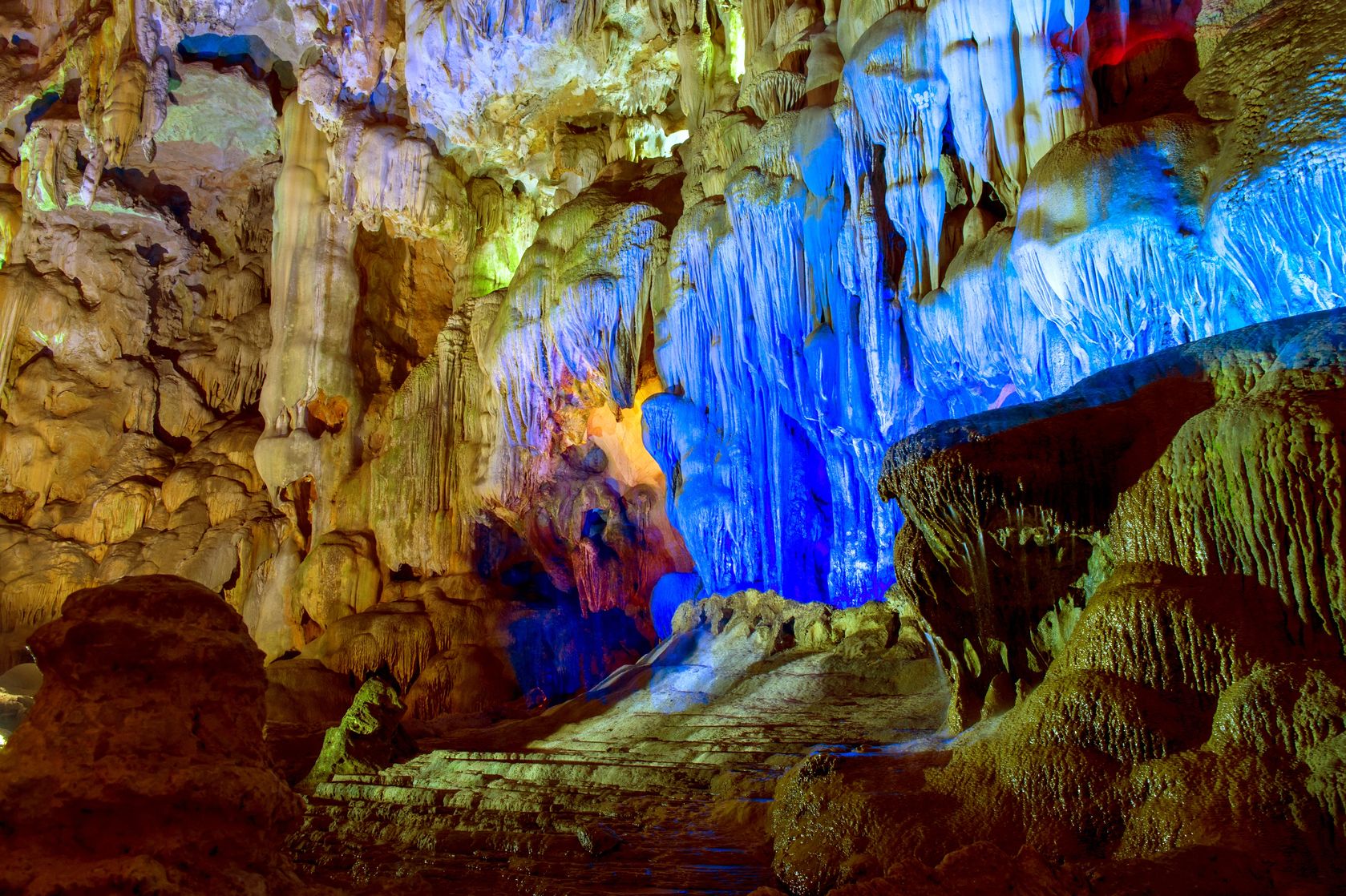Ha Long Bay is home to caves, islands, a few small beaches, and sleepy fishing villages. Between the leisurely pace of the bay’s cruise boats (a result of the high volume of traffic) and the sheer number of islands in the area, it’s impossible to reach all of Ha Long’s attractions on a single trip. Most overnight cruises do a nice job of hitting the more noteworthy spots. Because the bay is accessible only by boat tour, you’ll have little to no control of which sights you see once you’ve booked your trip. Check cruise company itineraries for particular attractions before booking. The entry fee for each cave (VND50,000) is usually included in the price of the cruise.

Ha Long Bay. Photo © Dana Filek-Gibson.
Dau Go Cave (8am-5pm daily) remains obscure, often overlooked on boat tours. Where visitors step off the narrow path leading out of Thien Cung and back to the boating docks, hang a right into Dau Go, about 100 meters away from Thien Cung; you will find it far less crowded and devoid of artificial additions. Its wide entrance opens onto the first chamber, a bright and cavernous room. A narrow pathway passes over limestone and under slender, bizarre stalactites, traveling the perimeter of the cave’s three chambers before looping back out to the front, where you’ll find a small stele engraved with the words of emperor Khai Dinh, who visited Dau Go in 1918.
Dau Go, known in English as the Cave of the Wooden Stakes, gets its name from a famous historical event. It was in this chamber that legendary Vietnamese general Tran Hung Dao prepared the ironwood stakes that he and his men would use to defeat the last Mongol invasion on the Bach Dang River in 1288. The general and his men sharpened the massive spikes and planted them in the nearby river, just deep enough to be invisible during high tide. When the Mongol ships sailed down the Bach Dang and the tide ebbed, they became trapped, propped up on a bed of spikes, and easily defeated by Vietnamese forces.

Inside the Dau Go Cave in Ha Long Bay. Photo © Nikolay Grachev/123rf.
Also known as Surprise Cave or Amazing Cave, Sung Sot Cave (8:30am-4:45pm daily) is a regular stop on overnight cruises. From its large opening, several steps and 82 feet above sea level, to the picturesque landing just outside the exit, Sung Sot’s vaulted chamber houses a variety of formations. One formation resembles the Buddha, while another, beside the cavern’s entrance, resembles a horse with a sword. According to local legend, this is where Thanh Giong, a Vietnamese folk hero, came to rest after defeating his enemies. The legend goes that when he died, Thanh Giong left behind his horse and sword at the mouth of Sung Sot in order to protect the cavern against demons. This cave’s expanse is impressive, though it can get crowded, and artificial lighting takes away from the natural appeal.
A few other spots feature on some tour itineraries and are equally as interesting, though not as popular as the most-visited caves. One of these is Golden Tortoise Cave (Dong Kim Quy), teeming with stalactites. According to local legends, this cave is the final resting place of Hoan Kiem Lake’s tortoise, a petrified stone formation deep inside the cave.
In the early 15th century, Vietnamese emperor Le Thai To used a magical sword to defeat Chinese invaders. Following his victory, the emperor was rowing on Hanoi’s Hoan Kiem Lake when a giant tortoise swam up to his boat, took the sword in its mouth, and disappeared beneath the surface. (This event earned Hoan Kiem Lake its name, which translates to Lake of the Returned Sword.) The tortoise took the blade back to Ha Long Bay where it encountered evil spirits and was forced to defend itself. Though it defeated the assailants, the tortoise was so exhausted that it found a cave in which to rest and soon after turned to stone. Today, visitors rub its back for good luck.
Follow the path through the stalactite and stalagmite formations, and you’ll pass the tortoise toward the end of the path.
Another storied set of caves are Virgin Cave (Dong Trinh Nu) and the adjacent Drum Cave (Dong Trong), named after a pair of unrequited lovers. The tale goes that there was a beautiful woman who loved a young fisherman. The couple hoped to marry, and so one day the young man set off to sea in order to catch fish for their wedding day. While the young man was away, the girl’s family, who was very poor, sent their daughter to live with a rich man. Devastated, the young woman refused to go, and her wealthy suitor exiled her to a small island in the bay, where she turned to stone. When the young man heard that she was in danger, he began searching for his lover. From his boat, he shouted as loud as possible but could not make himself heard over the weather, which had turned into a terrible storm. Wet and exhausted, he too turned to stone. In Virgin Cave, the formation is of a young woman lying down with her hair falling over her head, looking toward the sea. In Drum Cave, the formation is of a young man with his face turned toward Virgin Cave, as if calling to the woman. Cruise boats (including Gray Line boats) often stop outside the caves, as guides relate the story of the lovers. Tours don’t usually let passengers disembark to explore these caves.
The small Me Cung Cave occasionally makes it onto tour itineraries. Its contents offer fascinating insight into the ancient history of the bay, with several fossilized animal remains inside the narrow chamber. Tour guides can point out where the fossils are.
Farther afield on Dau Be Island, Ho Ba Ham, or Three-Tunnel Lake, is another seldom-visited spot that is sometimes included on tours stopping at Cat Ba. As the name suggests, its peaceful, walled-in lagoons are accessed by a series of tunnels, usually in wooden boats at low tide.
Excerpted from the First Edition of Moon Vietnam.